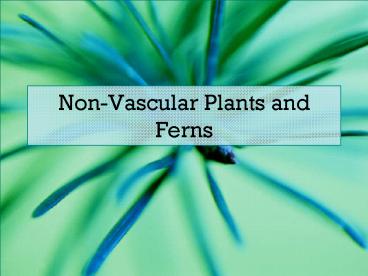Non-Vascular Plants and Ferns - PowerPoint PPT Presentation
1 / 19
Title:
Non-Vascular Plants and Ferns
Description:
The green algae called charophyceans are the closest ... Seeded Vascular Plants. Gymnosperms- conifers, cycads, and ginkgo. Angiosperms- flowering plants ... – PowerPoint PPT presentation
Number of Views:93
Avg rating:3.0/5.0
Title: Non-Vascular Plants and Ferns
1
Non-Vascular Plants and Ferns
2
Evolution of Land Plants
- Land plants evolved from green algae
- The green algae called charophyceans are the
closest relatives of land plants - Comparisons of both nuclear and chloroplast genes
- Point to charophyceans as the closest living
relatives of land plants
3
Origin and Diversification of Plants
- Fossil evidence indicates that plants were on
land at least 475 million years ago - Whatever the age of the first land plants those
ancestral species gave rise to a vast diversity
of modern plants
4
Plant Evolution
5
Bryophytes
- Life cycles of mosses and other bryophytes are
dominated by the gametophyte stage - Bryophytes are represented today by three phyla
of small herbaceous (nonwoody) plants - Liverworts, phylum Hepatophyta
- Hornworts, phylum Anthocerophyta
- Mosses, phylum Bryophyta
6
Bryophytes
7
Liverworts
- Have no true roots or shoots
- Non- vascular
- Require water to reproduce
- Have no or very little leaf structure
- Cannot live in sporophyte form
8
Hornworts
- Free-floating aquatic plant, or land plant
- No vascular tissue
- No true leaves or roots
- Can live in both gametophyte and sporophyte forms
9
Mosses
- Land plant
- Most have no vascular tissue
- Majority to life spent in gametophyte
- Need water to breed
- No leaves or roots
- Sporophytes are capsules on stalks
10
Vascular Plants
- Vascular plants have two types of vascular tissue
- Xylem and phloem
- Xylem
- Conducts most of the water and minerals
- Includes dead cells called tracheids
- Phloem
- Distributes sugars, amino acids, and other
organic products - Consists of living cells
11
Vascular Plants
- Vascular plants have roots
- Are organs that anchor vascular plants
- Enable vascular plants to absorb water and
nutrients from the soil - May have evolved from subterranean stems
- Vascular plants have leaves
- Leaves are organs that increase the surface area
of vascular plants, thereby capturing more solar
energy for photosynthesis
12
Vascular Plants
- Two types of vascular plants seedless and
seeded - Seedless vascular plants form two phyla
- Lycophyta, including club mosses, spike mosses,
and quillworts - Pterophyta, including ferns, horsetails, and
whisk ferns and their relatives - Modern species of lycophytes are relics from a
far more eminent past - Are small herbaceous plants
- Ferns
- Are the most diverse seedless vascular plants
13
Seedless Vascular Plants
14
Ferns
- Like vascular plants but do not have seeds
- Common in shady areas, diverse in the tropics
- Have flagellated sperm that require water to
reach the eggs
15
Alternation of Generations
- The seed plant life cycle contains both haploid
and diploid stages - Diploid individuals are called sporophytes
- Haploid individuals are called gametophytes
- Does not happen in algae
- May have evolved as an adaptation to harsh
environments - Haploid cells divide into a cluster of cells
before meiosis
16
Alternation of Generations
17
Dominant Gametophyte
- Mosses have a dominant gametophyte stage
18
Dominant Sporophyte
- Most plants have a dominant sporophyte stage
19
Seeded Vascular Plants
- Gymnosperms- conifers, cycads, and ginkgo
- Angiosperms- flowering plants































